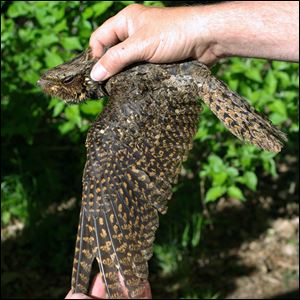
Rare visitor stops by
5/31/2009
A female chuck-will's-widow is out of its element in northwest Ohio at the Black Swamp Bird Observatory.
In the rural South it is not unusual to hear the evening song of a bird that continuously trills out its name, "chuck-will's-widow."
A member of the nightjar family and a large relative of the more familiar whip-poor-will, the chuck-will's-widow usually puts on the brakes by the time its springtime northbound migration reaches no farther than southern Ohio.
So it is no wonder that Mark Shieldcastle, research director for Black Swamp Bird Observatory near Oak Harbor, was excited over capturing and banding a female chuck-will's-widow recently at the BSBO site.
"It's only the second or third one recorded here and the first one we've seen in hand," he said. For perspective, know that the BSBO banding program stretches back more than 20 years and covers almost 495,000 birds among scores and scores of species.
When Shieldcastle caught the bird, it quickly opened its mouth and uttered a characteristic growl. "Its mouth was full of brown beetles, a couple of them were still alive."
The chuck-will's is mostly solitary, a nocturnal feeder, that can flutter away like a huge brown moth on silent wings. Like other nightjars, on roost it perches parallel to the limb, or it roosts on the ground where its mottled stealth-plumage makes it nigh impossible to spy.
The species is "half again as big as a whip-poor-will," said Shieldcastle. Average length is 12 inches with wings spanning about 25 inches. "The head is massive [for its size]. "You could put a baseball in its mouth."
For a whip-poor-will, researchers use the same size legband they would put on a cardinal. For a chuck-will's, they use a band fit for a flicker, or woodcock, or mourning dove. The bird's middle toenail, moreover, has a distinctive comb-like configuration.
Shieldcastle is hoping the female sticks around. Another chuck-will's, a possible male, was seen at the station but not captured, in mid April. He plans to be out evenings, listening and watching.
Should there be a nest here, it would be big news. In southern Ohio, the usual northern extent of their range, these birds usually nest in river bottoms. Whip-poor-wills nest well into and beyond the Great Lakes, as do another relattve, common nighthawks.
Urban dwellers may not realize it, but they probably know the nighthawk, or bullbat as it is known in the South. Nighthawks are those swift, highly maneuverable birds that carve arcs around streetlights and athletic field floodlights on summer evenings, feeding on mosquitoes and other insects. Unlike like the chuck-will's or whip-poor-will, however, bullbats do not say their names. Rather that "peent!" like a woodcock as they fly open-mouthed, scooping up supper.
In related news, the final big major wave of spring migration is coursing through the region, making for what has been a tremendous migration season, Shieldcastle said.
BSBO noted record numbers of myrtle, blackpoll, yellow, palm, and Nashville warblers, and large numbers of such "overflight" species as pine, worm-eating, and parula warblers.
•
Seven teams of birders in the Toledo Naturalists' Association tallied 200 species of birds in a day in the Toledo area during its recent annual North Coast Opening tournament.
The results included such highlights as red crossbill, sandhill crane, clay-colored sparrow, and Wilson's phalarope. TNA said the Open's composite list demonstrates the tremendous birding opportunities in northwest Ohio. TNA Open teams typically fan out from the Oak Openings on the west to the western Lake Erie marshes on the east, and adjacent areas inland.
•
Toledo Area Metroparks and the Andersons are sponsoring a 7 a.m. public bird walk at Side Cut Metropark Tuesday, beginning at the Tom Anderson Bird Observatory on the Anthony Wayne Trail level of the park.
The walk will be led by John Robinson, a renowned ornithologist representing Scotts Bird Feeds. After the walk, Robinson will conduct three seminars on bird feeding at 9:30 and 11 a.m., and 1 p.m., at The Andersons store on Illinois Avenue in Maumee.
He is an award-winning ornithologist and wildlife biologist of 30 years, including work at the U.S. Department of Agriculture and the U.S. Fish and Wildlife Service. A national expert on birding, Robinson has led bird watching tours all over the world and is author of the book, Birding for Everyone.